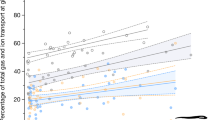Summary
Transmission electron microscopy has not provided strong evidence for gap junctions inMytilus edulis gill tissue, in spite of extensive physiological evidence for coupled ciliary arrest in lateral cells and coupled activation in abfrontal cells. To investigate the kinds and relative distribution of cell junctions and also to determine whether ciliary membrane particle differences exist in these two types of oppositely mechanically sensitive cells, we analyzed the structure of these and two other ciliated cell types (frontal and laterofrontal) by freeze-fracture replication. Gap junctions occur in all four ciliated cell types, but they are relatively small and of variable morphology, often consisting of elongate, winding complexes of membrane particles. Statistically, such structures rarely would be recognized as gap junctions in thin sections. Gap junctions appear to be most abundant between the highly coupled abfrontal cells, minimal between laterofrontal cells, and not evident in the epithelial cells that separate coupled ciliated cell types. The ciliary necklaces of the mechanically activated abfrontal cilia are typically 4- or 5-stranded while those of the remaining three cell types are mainly 3-stranded. In developing gill tips, ciliated cells have abundant gap junctions and newly formed cilia have a full complement of necklace particles. Nascent lateral cilia are not mechanically sensitive, indicating that the acquisition of mechanosensitivity does not correlate with the presence of ciliary necklace or other membrane particles. Lateral and laterofrontal cells become sensitive to neurotransmitters soon after the appearance of the latter during development, but mechanosensitivity of both lateral and abfrontal cells arises substantially later.
Similar content being viewed by others
References
Ash BM, Stephens RE (1975) Ciliogenesis during the sequential formation of molluscan gill filaments. Dev Biol 43:340–347
Dute R, Kung C (1978) Ultrastructure of the proximal region of somatic cilia inParamecium tetraurelia. J Cell Biol 78:451–464
Gilula NB, Satir P (1971) Septate and gap junctions in molluscan gill epithelium. J Cell Biol 51:869–872
Gilula NB, Satir P (1972) The ciliary necklace. A ciliary membrane specialization. J Cell Biol 53:494–509
Gilula NB, Branton D, Satir P (1970) The septate junction: a structural basis for intercellular coupling. Proc Natl Acad Sci USA 67:213–220
Good MJ, Stephens RE (1987) Freeze-fracture analysis of coupled ciliated epithelial cells in mussel gill J Cell Biol 105:226a
Gray J (1928) Ciliary movement. Cambridge Univ Press, Cambridge
Hohenberg H, Mannweiler K (1980) Semi-automatic washing device for simultaneous cleaning of surface replicas under identical conditions. Mikroskopie (Wein) 36:145–154
Hudspeth AJ, Revel J-P (1971) Coexistence of gap and septate junctions in an invertebrate epithelium. J Cell Biol 50:92–101
Johnson RG, Hammer M, Sheridan JD, Revel J-P (1974) Gap junction formation between reaggregated Novikoff hepatoma cells. Proc Natl Acad Sci USA 71:4536–4540
Lane NJ (1978) Developmental stages in the formation of inverted gap junctions during turnover in the adult horseshoe crab,Limulus. J Cell Sci 32:293–305
Lane NJ, Swales LS (1978) Changes in the blood-brain barrier of the central nervous system in the blowfly during development, with special reference to the formation and disaggregation of gap and tight junctions. II. Pupal development and adult flies. Dev Biol 62:415–431
Lane NJ, Swales LS (1980) Dispersal of gap junction, particles, not internalization, during in vivo disappearance of gap junctions. Cell 19:579–586
Larsen WJ, Risinger MA (1985) The dynamic life histories of intercellular membrane junctions. Mod Cell Biol 4:151–216
Menco BPhM (1988) Pre-natal development of rat nasal epithelia. V. Freeze-fracturing on necklaces of primary and secondary cilia of olfactory and respiratory cells. Anat Embryol 178:381–388
Montesano R (1980) Intramembrane events accompanying junction formation in a liver cell line. Anat Rec 198:403–414
Murakami A, Machemer H (1982) Mechanoreception and signal transmission in the lateral ciliated cells on the gill ofMytilus. J Comp Physiol 145:351–362
Owen G (1974) Studies on the gill ofMytilus edulis: the eu-laterofrontal cirri. Proc R Soc Lond [Biol] 187B:83–91
Plattner H (1975) Cliary granule plaques: membrane-intercalated particle aggregates associated with Ca2+-binding sites inParamecium. J Cell Sci 18:257–269
Reed W, Satir P (1981) Septate junction disruption and surface reorganization by non-lethal Ca2+ shock. Cell Biol Int Rep 5:469–478
Rice EL (1908) Gill development inMytilus. Biol Bull 14:61–77
Sanderson MJ, Chow I, Dirksen ER (1988) Intercellular communication between ciliated cells in culture. Am J Physiol 254:C63-C74
Satir P, Gilula NB (1970) The cell junction in a lamellibranch gill ciliated epithelium. J Cell Biol 47:468–487
Satir B, Sale WS, Satir P (1976) Membrane renewal after dibucaine deciliation ofTetrahymend. Exp Cell Res 97:83–91
Sattler CA, Staehelin LA (1974) Ciliary membrane differentiations inTetrahymena pyriformis. Tetrahymena has four types of cilia. J Cell Biol 62:473–490
Stephens RE, Stommel EW (1989) Role of cyclic adenosine monophosphate in ciliary and flagellar motility. In: Warner FD, Satir P, Gibbons IR (eds) Cell movement, vol I. The dynein ATPases. Allan R Liss, New York, pp 299–316
Stephens RE, Oleszko-Szuts S, Good MJ (1987) Evidence that tubulin forms an integral membrane skeleton in molluscan gill cilia. J Cell Sci 88:527–535
Stommel EW (1984a) Calcium regenerative potentials inMytilus edulis gill abfrontal ciliated epithelial cells. J Comp Physiol 155A:445–456
Stommel EW (1984b) Calcium activation of mussel gill abfrontal cilia. J Comp Physiol 155A:457–469
Stommel EW (1986) Mechanical stimulation activates beating in calcium-arrested lateral cilia ofMytilus edulis gill. J Muscle Res Cell Motil 7:237–244
Stommel EW, Stephens RE (1988) EGTA induces summed depolarizations inMytilus gill coupled epithelial cells: Implications for the control of ciliary motility. Cell Motil Cytoskel 10:464–470
Stommel EW, Stephens RE, Alkon DL (1980) Motile statocyst cilia transmit rather than directly transduce mechanical stimuli. J Cell Biol 87:652–662
Tamm SL (1972) Ciliary motion inParamecium. J Cell Biol 55:250–255
Yancey SB, Nicholson BJ, Revel J-P (1981) The dynamic state of liver gap junctions. J Supramol Struct Cell Biochem 16:221–232
Yee AG, Revel J-P (1978) Loss and reappearance of gap junctions in regenerating liver. J Cell Biol 78:554–564
Author information
Authors and Affiliations
Rights and permissions
About this article
Cite this article
Good, M.J., Stommel, E.W. & Stephens, R.E. Mechanical sensitivity and cell coupling in the ciliated epithelial cells ofMytilus edulis gill. Cell Tissue Res. 259, 51–60 (1990). https://doi.org/10.1007/BF00571429
Accepted:
Issue Date:
DOI: https://doi.org/10.1007/BF00571429




